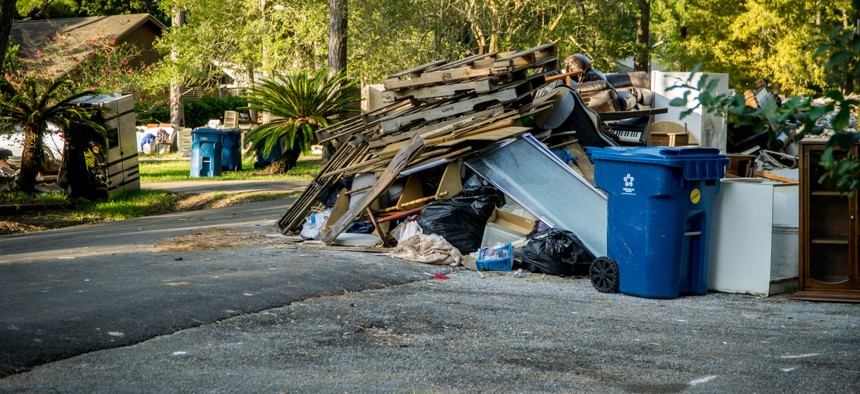Emergency Managers Ask Congress to Invest in Mitigation

Debris and personal belongings from gutted homes in the streets of Dickinson, Texas, days after Hurricane Harvey made landfall in 2017. Shutterstock
Resilience projects could cut the costs of future disasters at a time when FEMA wants state and local governments to pitch in more during response.
WASHINGTON — State and local officials expressed support Wednesday for legislation allowing them to put a portion of disaster costs toward mitigation, as the Federal Emergency Management Agency stresses greater intergovernmental coordination.
The Disaster Recovery Reform Act proposed by U.S. Rep. Lou Barletta, a Republican from Pennsylvania, would shift 6 percent of annual disaster grants into a National Public Infrastructure Pre-Disaster Mitigation Fund for resilience projects.
Tennessee Emergency Management Agency Director Patrick Sheehan called the provision a “gamechanger” during a House subcommittee meeting on 2018 hurricane season preparedness.
Resilience funding “will fundamentally change how we prioritize and manage mitigation in this nation … and drive down future disaster costs,” Sheehan said.
Sheehan, who testified before the subcommittee on behalf of the National Emergency Management Association, further advocated for increasing the amount of federal dollars available for management costs. That number would go from 3 to 12 percent—7 percent for states and 5 percent for localities—but NEMA hopes to ensure the money will roll over from one disaster to the next.
State and local governments want increased mitigation funding because of FEMA’s push for them to assume greater responsibility in an era of collaborative disaster management.
In 2017, U.S. disasters affected an estimated 47 million people and caused $370 billion in damages. FEMA acknowledged numerous shortcomings—particularly in the case of of Hurricane Maria and Puerto Rico—in an after-action report released on July 12.
The report also called attention to areas where FEMA found itself performing the role of state and territorial governments, at a time when the agency is looking for them to do more.
Jeffrey Byard, the associate administrator of FEMA’s Office of Response and Recovery, emphasized the growing role of states and localities, as well as the private sector, during the hearing.
“As part of our initiative to ready the nation for catastrophic disasters, we are emphasizing stabilization of critical lifelines and coordination across critical infrastructure sectors,” Byard said. “We have to bring more people under our tent.”
The federal government should reward communities investing in resilience and stronger building codes and cutting disaster costs, rather than creating a “giveaway program,” said former FEMA Administrator David Paulison.
By reducing FEMA’s complexity and making funding streams predictable, Congress can help states and localities justify otherwise time-consuming mitigation projects, Sheehan said.
“The more you do in policy to add incentives … it gives us the leverage to do those mitigation steps even though they are lengthy and they are costly,” said Mistie Gardner, emergency management coordinator for Richardson, Texas.
About 650 Puerto Ricans still lack power after Hurricane Maria, one month into a 2018 hurricane season that’s already seen two hurricanes form in the Atlantic. And in the U.S. Virgin Islands students continue to learn in 4-hour shifts at overcrowded schools because so many were damaged, while in-patient treatment at hospitals occurs mostly off island for similar reasons.
The damaged homes of low-income families in both territories often feature blue roofs—only meant to last 30 days.
U.S. Rep. Peter DeFazio, a Democrat from Oregon, the ranking member of the committee, called FEMA’s response in the case of both territories “outrageously inadequate.” And while the after-action report acknowledges FEMA’s failures, the agency is currently scrubbing references to “climate change” from its literature while the Trump administration proposes budget cuts to disaster preparedness, he said.
“We need to do better, we need to act smarter, we need to do, actually, all these things that have been enumerated,” DeFazio said. “And Congress is the only hope we have for delivering on that reality.”
Dave Nyczepir is a News Editor at Government Executive’s Route Fifty and is based in Washington, D.C.
NEXT STORY: These Pills Could Be Next U.S. Drug Epidemic, Public Health Officials Say






